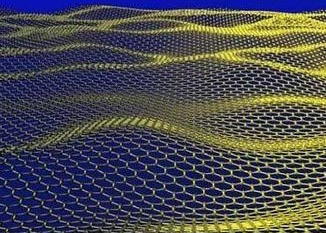 Recently, the physicists' organization network reported that researchers from the Northwestern University School of Materials Science and Engineering used tiny graphene sheet inks to print 250 times more conductive properties in ink-jet printing mode, and only slightly decreased electrical conductivity when folded. With flexible electrodes, it is possible to produce inexpensive, large, foldable and delicate electronic devices in the future. The research results were published in the latest issue of Physical Chemistry Letters.
Recently, the physicists' organization network reported that researchers from the Northwestern University School of Materials Science and Engineering used tiny graphene sheet inks to print 250 times more conductive properties in ink-jet printing mode, and only slightly decreased electrical conductivity when folded. With flexible electrodes, it is possible to produce inexpensive, large, foldable and delicate electronic devices in the future. The research results were published in the latest issue of Physical Chemistry Letters. Researcher Ethan B. Seeker explained that inkjet printing can produce flexible substrates with low cost and large area, which is an attractive method for producing electronic components. Previous studies have printed out various components such as transistors, solar cells, light emitting diodes, sensors, etc., but printing highly conductive electrodes is still a challenge because it requires very fine resolution. The new research turned to graphene with high conductivity and chemical stability. It is hoped that graphene can print out electrodes as ink.
One of the most important steps in graphene printing is to obtain a large amount of graphene. In the current process for the production of neat graphene by stripping, the commonly used solvents and surfactants leave a residue, thereby reducing their electrical conductivity. Another problem is that the small graphite sheets require high printing stability, and their large number of sheet junctions also reduce the electrical conductivity.
To overcome these problems, researchers developed a new method that uses ethyl alcohol as a solvent and ethyl cellulose as a stable surfactant at room temperature. Ethanol and ethyl cellulose do not produce residues. The graphene black powder produced by the new method has a graphene sheet size of about 50×50 square nanometers and a thickness of about 2 nanometers. Although there are myriad of snow-like connections between such flake size graphenes, the high stability of the ethyl cellulose polymer greatly reduces the resistance between the flake compared to other surfactants.
The researchers dispersed the graphene black powder into a solvent to create a liquid ink. In the demonstration, it was found that graphene ink shows excellent morphology and conductivity in printing, and the precise printing mode is suitable for printed electrodes. They also used polyimide as the substrate to evaluate the mechanical properties of the graphene ink. It was found that the conductivity of the ink is very high. Even if the substrate is greatly bent, cracks may even begin to appear and the conductivity will remain unchanged. When they folded the substrate, the ink's conductivity was reduced by only 5%. Mechanical performance tests show that graphene inks can be used to produce folded electronic devices in the future.
The University's Mark said: "In essence, all electronic devices and circuits require high conductivity and high resolution electronic contacts and interconnections. Therefore, graphene inks may affect a wide range of applications, especially Flexible electronic products, folding electronic devices Applications of these types of electronic devices include smart phones, tablet computers, flat panel displays, and solar cells.
He also stated that the future will focus on the use of graphene printing in the assembly of electronic devices and circuits, including various products in the application fields listed above.
1.Application : For printer and copier machine
2.Dimension: Customized dimension, OEM & ODM
3.Material: A6063, A6061, A3003 and other series alu alloy
4.Suface treatment: Anodizing, polishing, turning ,power coating, mill finish etc
5.Equipment: CNC ,extruding machine, cold drawn machine, heating oven, straightening machine, cutting machine
|
OD |
OD Tolerance |
ID Tolerance |
Roundness |
Straightness |
Circular run-out |
|
φ16-20 |
±0.02 |
±0.02 |
0.01↓ |
0.015↓ |
0.05↓ |
|
φ20-30 |
±0.02 |
±0.02 |
0.01↓ |
0.015↓ |
0.05↓ |
|
φ30-50 |
±0.05 |
±0.05 |
0.02↓ |
0.020↓ |
0.08↓ |
|
φ50-80 |
±0.15 |
±0.10 |
0.05↓ |
0.025↓ |
0.10↓ |
6. STANDARD PACKING:Wooden case/carton
7. Trade Terms
1. Payment: 30% T/T in advance, 70% balance pay before delivery. L/C at sight.
2. Delivery time: 20 days after deposit receiverd. If opening mould, plus 7-10 days.
3. Trade Term can be chosen depending on your requirements.
4. FOB Port: Shanghai
Extrusion Tube For Printer And Copier
Extrusion Tube For Printer,Extrusion Tube For Copier,Aluminium Extruding Tube,Aluminum Extrusion Pipe
Changzhou YiFei Machinery Co., Ltd. , http://www.yifeialu.com